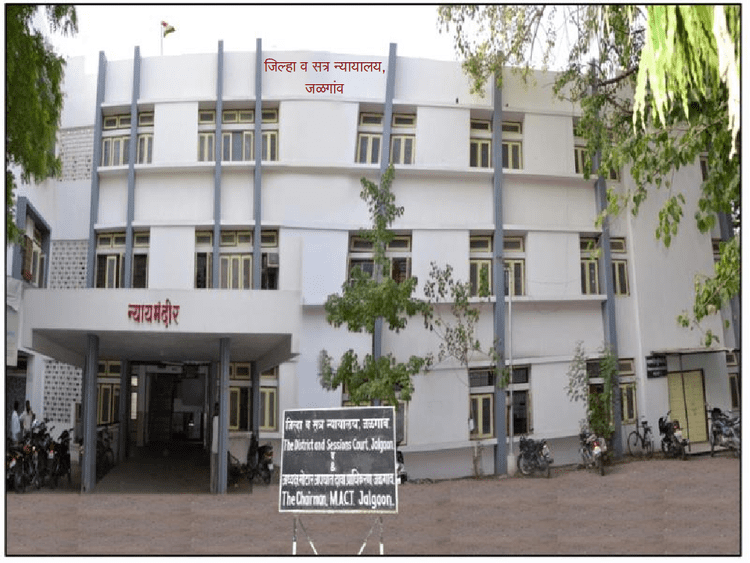Area 11,765 km² | Headquarters Jalgaon Average annual precipitation 690 | |
 | ||
Tehsils Jalgaon, Jamner, Chalisgaon, Dharangaon, Bhusawal, Bodwad, Yawal, Raver, Muktainagar, Amalner, Chopda, Parola, Pachora, Erandol Major highways NH-6 National Highway 211 (India) NH-211 Destinations Points of interest Gandhi Teerth, Patnadevi, Satpuda Manudevi Temple, Parola Fort, Mangal DEV Graha Mandir | ||
Jalgaon is a district of Maharashtra, India, which was known as East Khandesh until 21 October 1960. It has an area of 11,765 km² and a population of 4,224,442 as of the 2011 census. Its capital is the city of Jalgaon.
Contents
- Map of Jalgaon Maharashtra
- History
- Agriculture
- Climate
- Waterways
- Divisions
- Languages
- Education
- Media
- Notable people
- Places of interest
- Architectural sites
- Natural attractions
- Temples
- Hill stations
- References
Map of Jalgaon, Maharashtra
It is bounded by the state of Madhya Pradesh to the north and by the districts of Buldhana to the east, Jalna to the southeast, Aurangabad to the south, Nashik to the southwest, and Dhule to the west.
History
The present territory of Jalgaon was part of the independent Khandesh sultanate ruled by the Faruqi dynasty from 1382–1601. According to Abu'l Fazl ibn Mubarak's Ain-i-Akbari, the name Khandesh was derived from the Khan title given by Ahmed I of Gujarat (1411–43) to Malik Nasir, the second of the Faruqi kings. Other sources say the name comes from the Khandava Forest of the Mahabharata, which describes a conflict between Yuvanashva—the ruler of Toranmal, present-day Nandurbar district—and the Pandavas.
The rock temples and caves at Nashik and Ajanta show that during the first three centuries AD, Khandesh was ruled by Buddhists. Thereafter, it was ruled by the Satavahana dynasty, the Ahirs, the Chalukya dynasty, and the Yadava dynasty, followed by Alauddin Khilji, Mohammad Tughlak, and Malik Nasir. After its annexation by Akbar in 1601, the district became a subah of the Mughal Empire. Subsequently, it was ruled by the Nizam of Hyderabad and the Marathas.
In the early 18th century, Khandesh was captured by British troops from the Holkar regime, and Dhule was established as its capital. Robert Gill was the first administrator of the British East India Company in the district.
In 1906, the district was divided, with East Khandesh covering the territory that is now Jalgaon. After the 1956 reorganisation of India's states, East Khandesh became part of Bombay State. Four years later, in 1960, it became part of the newly formed Maharashtra and was renamed Jalgaon.
Agriculture
The major crops produced in the district are banana (Jalgaon is the top banana producer in Maharashtra), cotton, sorghum, wheat, millet, lime, peanut, and sugarcane.
Climate
On average, Jalgaon receives between 77 cm and 80 cm of rainfall per year. In the easternmost part of the district—i.e., in Yawal—the average annual rainfall is 77 cm; in Bhusawal, Pachora, and the city of Jalgaon, it is 79 cm; and in Jamner, it is 80 cm.
Waterways
The Tapti River flows through Jalgaon from the north. Its total length is 724 km, of which 208 km are in Maharashtra. The Tapti has numerous tributaries in and around Jalgaon, including the Aner, Bhuleshwari, Biswa, Chandrabhaga, Dolar, Gadgi, Kapara, Katpurna, Man, Morana, Nalganga, Nand, Pedhi, Sipana, and Wan Rivers.
The Waghur and Girna Rivers also run through the district. The Girna—an important source of water for irrigation—originates in Nashik and ends near Nanded, where it runs almost parallel with the Tapti before flowing into it.
Divisions
Jalgaon district consists of 15 talukas, or tehsils: Amalner, Bhadgaon, Bhusawal, Bodwad, Chalisgaon, Chopda, Dharangaon, Erandol, Jalgaon, Jamner, Muktainagar, Pachora, Parola, Raver, and Yawal. Jalgaon city is the administrative headquarters.
The district has 11 constituencies in the Vidhan Sabha, the state legislative assembly: Amalner, Bhusawal, Chalisgaon, Chopda, Erandol, Jalgaon City, Jalgaon Rural, Jamner, Muktainagar, Pachora, and Raver. It has two constituencies in the Lok Sabha, the lower house of the Indian Parliament: Raver and Jalgaon.
Demographics As of the 2011 census, Jalgaon district had a population of 4,224,442, roughly equal to that of the Republic of the Congo or the US state of Kentucky. It is the 46th most populous of India's 640 districts.
The population density is 359 inhabitants per square kilometre (930/sq mi). The population growth rate from 2001–11 was 14.71%. Jalgaon has a sex ratio of 922 females for every 1000 males, and a literacy rate of 79.73%.
Languages
The languages spoken in Jalgaon include Ahirani, a dialect of Khandeshi with approximately 780,000 speakers, similar to Marathi and Bhili; Palya Bareli, a Bhil language with approximately 10,000 speakers, centred in Madhya Pradesh; and Rathwi Bareli, a Bhil language with approximately 64,000 speakers, written in the Devanagari script and mutually unintelligible with Palya Bareli.
Education
North Maharashtra University was established in the city of Jalgaon on 15 August 1989. Government Polytechnic Jalgaon was established in 1960. The district is also home to schools and colleges of the Khandesh Education Society and Maratha Vidya Prasarak Mandal.
Media
The major Marathi-language newspapers published in Jalgaon are Deshdoot, Deshonnati, Divya Marathi, Lokmat, the Maharashtra Times, and 'Sakal'.
Notable people
Places of interest
Attractions in Jalgaon district include Gandhi Teerth (a research institute and museum run by the Gandhi Foundation) and the Jain Research and Demonstration Center, which is focused on agriculture. There are also the remains of a fort believed to have belonged to the father of the Rani of Jhansi.
Additionally, the district was the site of the first session of the Indian National Congress in 1936, led by Jawaharlal Nehru.
Other sites of interest include:
